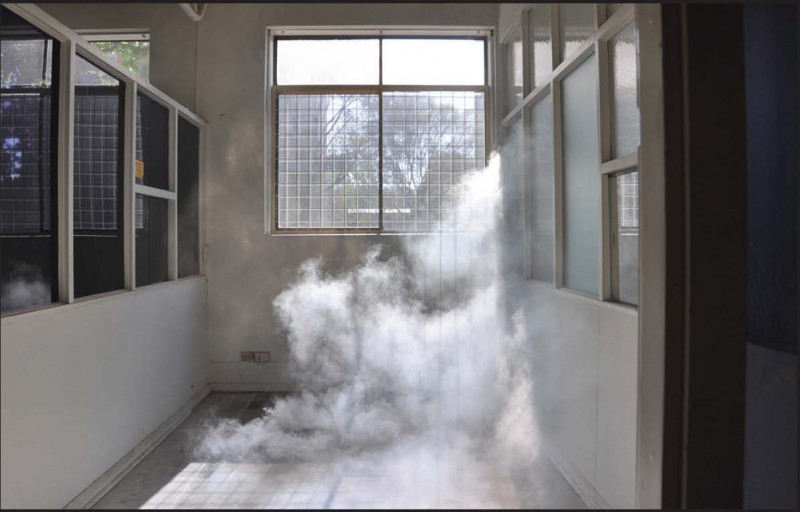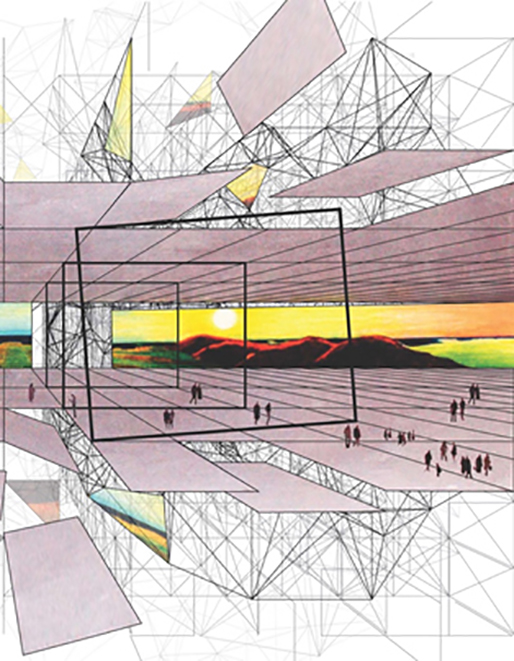First-class final project
Abstract
The following is a conversation between final year design coordinators Interior Design (Hons) RMIT University Melbourne - overseeing a year-long research focused design proposal. Phoebe Whitman (2018 - 2019), Anthony Fryatt (2015-2017) and Roger Kemp (2009-2014). The conversation discussed an exemplary project from each of those time periods chosen by the respective coordinator.
Question: What high distinction (first-class) student project from your time as final year coordinator continues to resonate with you? What made this work so good?
Roger Kemp [RK]: A project that stands out for me is Bethany Ryan’s project titled ‘Filled Space: An Investigation into Air’’ from 2009 (which is 10 years ago now). The project was attempting to somehow visualise or intensify the perception of air.
Primarily the value of the work for me is in the innovation of the idea of working with an immaterial substance. One which has a significant affect on interior spaces. We continue to privilege the visual description and representation of interiors over the more elusive conditions - things like air and temperature. Bethany’s work was positioned as a ‘practice’ rather than a ‘project’. It was presented as a collection of projects rather than a singular design. It had a strong philosophical agenda beyond the well-crafted and consistent iterative experimentation.


Phoebe Whitman [PW]: Breeanna Hill’s project “Transcending Physicality” (2018) was a project that strongly resonated with me; it was a timely project that took creative risk. Breeanna had begun to develop a practice as she entered into the final year of her studies, which she was able to extend further into a rigorous and in-depth way of working with digital processes and materials. The project, situated in the share house economy, explored how virtuality could facilitate a transformative and dynamic mode of dwelling through the production of a series of virtual phenomena that facilitate connectedness via the dissolution of perceptual boundaries.
Breeanna presented a project that embraced both theory and practice where the panel was able to experience the essential qualities and effects of the proposal. It demonstrated how a major project could be both philosophical and speculative to enrich an expansive design thinking.




Anthony Fryatt [AF]: A memorable project would be Laura Casey’s “Rearranging Place: an exploration into the relationship between space and place” (2015). It was considered outstanding for its consistent design experimentation, philosophical curiosity, solid theoretical framework and exemplary design outcomes. The work in the form of drawings and autonomous models allowed for an active process of rearranging and place-making, ultimately proposing the encounter with a site could be shifted from the didactic to one of participatory place-making.


A telling quality of a ‘first-class project’ is one where the research trajectory is pursued across the entire year i.e. both the exploratory and major project semesters. Laura’s final major project was commendable not just for the refined quality of drawings and artefacts produced, but also the speculative, research-led nature of the brief and a commitment to pursue the early research question into the subsequent major project.
Question: How do we recognise a first-class project we see it?
[RK]: As a proposition (speculative or not) I see a first-class project making a strong contribution to the ‘community of ideas’ within the group of students, the staff and the culture of the academy at that time. Not in the sense of a PhD which makes a contribution to knowledge or contribution to the field or discipline, but as a timely contribution of ideas that asks us all to think differently. As an artefact, it should carry the aspiration of the ideas, not only as effective representational communication, but be compelling as an expression of the values of the ideas. Timeliness is important in that the work holds currency or value both to the designer and others.
[AF]: To Roger’s point, a clear demonstration of curiosity and disciplinary risk-taking through the medium of design would be important. In addition, there would be a rigorous or compelling research question underpinning the design research exploration and subsequent major project. Another key aspect would be student’s ability to direct the research project beyond their own individual priorities towards an external or broader cultural/social/political issue. As a given, there would be a convincing use of relevant communication and technologies in the design of the project. Lastly within the program, there is a particular emphasis placed on the presentation, in this respect, we are looking for a compelling visual arrangement of the work and critical verbal presentation of the research agenda and project outcomes.
[PW]: As a coordinator, one of the most exciting aspects of the final year project is observing how students can develop the beginning of a practice and see value in addressing a relevant issue or innovating an existing program. The work that stands out are the projects which take on a multiplicity of things, such as theory, materiality, contextual issues to build complexity, where the result isn’t conclusive but allows for an opening up to the potential of something new, something emergent.
Question: Do you think this has changed over the years? Have our expectations shifted?
[PW]: I don’t think this has changed on a fundamental level. However, there seem to be more permeable complexities, forces, matters at the forefront; the socio-political, environmental issues are omnipresent. Due to technologies and the post-internet age we live and operate in, interior design needs to take on more, address more, be more effective and thus there is an intensive and extensive need to innovate and produce interiors which address a multiplicity of things. The pressure in education is also greater due to these circumstances, and in a sense, students expect more from their education. This is what makes the final year self-directed project so relevant, as it reveals the flow of thinking and collective mindfulness of a generation of designers.
[AF]: Fundamentally no, I think our underlying understanding of what constitutes a great research project is essentially the same. I do think the ideas around interior design and interiority have evolved, in staff, students and the discipline. To help with understanding expectations students have a library of precedent major projects to browse; one effect of this is that students have progressively built upon ideas, there are at times lineages of an idea, modes of practice, types of projects etc. that staff and students are conscious of. I would say all of these things help to move the disciplinary culture along.
[RK]: No, I don’t think the expectations have changed, however, a project from 10 years ago is 10 years old and speaks to that time. Communication technologies have changed over that period of time - and therefore we are seeing much more sophisticated visualisations and material artefacts through digital fabrication. There was probably a time when some of these advancements influenced our assessment of a project, but this is tempered as we become more familiar with these tools.
Question: Do you think our teaching is getting better?
[PW]: I do think our teaching has developed. The generation of students coming through the program now seems younger and more strategic in that they have forces that are affecting what they want to achieve from their education that perhaps we did not face when we were students, in the same intensity. On a fundamental level teaching has to do more now, it has to be not just relevant, applicable, sensitive, but also socio-political and culturally sensitive in ways that affect the way one teaches, and a student learns. I find that these forces add layers of complexity and mean we need to be agile. I see this through the way my colleagues operate, as more of us finish PhDs and have developed practices which expand disciplinary thinking and boundaries. This folds back into our teaching approaches and the kind of content we teach, which has to keep changing and evolving. Teaching can’t be repetitive as this is static and as things move so quickly around us now and access to things is immediate, one always needs to keep adapting, which I think produces a greater quality of education.
[AF]: It is a different teaching context to 10 years ago, there are more students, certainly more external pressures on students and staff alike. This has demanded change and improvements in teaching. For instance, there is increased recognition of diversity in cultures and learning styles. We have worked hard to articulate our expectations, to transition students into an independent way of learning, to communicate better what is being asked of them and offer possible ways to approach the year. We have also become more conscious of introducing certain learning expectations, such as criticality or research strategies, earlier in the program. This way students are more prepared coming into a challenging self-directed final year.
[RK]: Yes, I think our teaching is better; in that the structure for classes and the resources are more scaffolded. We provide more comprehensive resources and support for students. The more important question might be whether they are learning better. I suspect the increasing number of students in our final year has changed the dynamic to some degree. Teaching to larger cohorts requires greater levels of organisation and more comprehensive communication systems to ensure all the staff and students are coordinated. Given the more comprehensive resources provided to the students and an increased level of education of staff, completing or having completed a PhD, I would suggest there is a higher level of academic quality.

